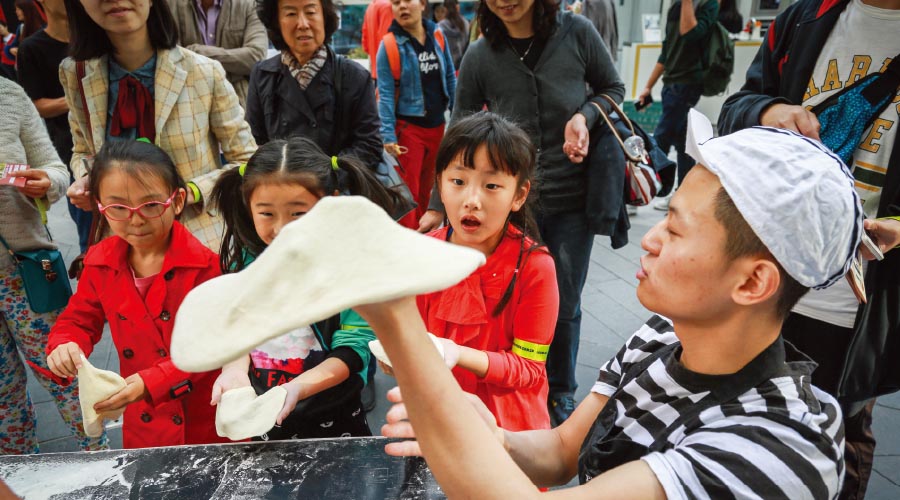Pizza is Italian. But much of the pizza that the world eats is actually American-style pizza. Unless you prefer funkier base sauces, like alfredo or Thousand Island, then it might be Japanese or Korean. Or maybe, just possibly, if you look at what a pizza is – a large baked crust with toppings, then could pizza have originated in China?
It would depend on the definition of pizza. While the constant argument about whether noodles were first created in China or Italy receives far more attention, there is also a case to be made for possible Chinese origins of one of the world’s favorite dishes. Unleavened, pancake-like edibles made from flour, rolled thin, and then steamed, baked, or fried, are ubiquitous, having appeared in numerous Central Asian, Mediterranean, and Middle Eastern countries as far back as 5,000 years. Manna, which appears in the Book of Exodus, was described as a “fine, flake-like thing,” with unleavened bread popping up elsewhere in the same book.
Beijing Bing
Similarly, the various bing (饼) that are mainstays of the northern Chinese diet also have their origins from thousands of years ago, most likely in China’s original cultural heart, the Yellow River valley, still a primary growing area for wheat.
If Marco Polo, always the figure placed at the center of the Sino-Italian struggle over the origin of noodles, was also the conduit for pizza, then he would have been quite late to the game.
Contact between China and the Roman Empire dates to about 100 CE/AD, although most of that was simple awareness of each other and an indirect exchange of goods via the Middle East and Central Asia.
Roman Holiday
There is also the possibility that the fabled Lost Roman Legion may have delivered pizza to China. Supposedly this group of Roman soldiers escaped east out of Iran in 53 BCE, following the capture and execution of their commander. They are believed by some Chinese and Western scholars to have reached and settled in western Gansu province about 15 years later, and remained, employed as mercenary soldiers. DNA testing of local residents shows that there is Caucasian ancestry in the area, as does anecdotal and visual evidence of villagers with green eyes. However, no chain of Roman pizzerias survived to the present day.
STORY: Deep Dish Your Thing? Then a Trip To Wangjing’s Yummy Box is in Order
A few factors cast doubt on the possibility of pizza originating in China. Although flour products and the aforementioned bing were early components of Chinese food, baking was not, and still is not, a common method of food preparation in Chinese cuisine.
Second, dairy products only became a regular component of the local diet – and even then it is somewhat limited to urban centers – in the last 20 years, with cheese lagging well behind the drinking of milk and yogurt as favorites. While dairies such as Meng Niu are now big companies known for sponsoring some of China’s most popular television shows, they’re making their money from the liquid product, not from selling cheese. Even now with the wide availability of dairy products in Beijing, one doesn’t see the average baozi stuffed with cheese. Your local jianbing guy may ask if you want hot sauce, but he never says, “Can I sprinkle a little mozzarella on there for ya?” (Actually that sounds pretty good). Pizza’s culinary conquest of China is really just a small victory won in the country’s larger dairy revolution.
Polo on Pizza
And what about Marco Polo? Well, if he encountered pizza for the first time during his legendary travels in China, he never mentions it once in his hundreds of pages of description of China. Polo was from Venice, although Naples is widely recognized as the birthplace of pizza in Italy. There certainly are a lot of pizza places named for him, though (Google it).
Lastly, China rarely if ever claims to have invented pizza. While a few stalwarts may insist on its Chinese origins, the idea just never gets the same play as having invented things like noodles, football, and fortune cookies.
But actually, none of this matters. Pizza’s popularity in Beijing is indisputable. According to restaurant review and coupon site Dianping.com, Beijing’s top 12 pizzerias operate a combined 353 outlets. Of the top 12, two-thirds are locally-founded pizza companies. Over 150 different pizza operators were named during the nomination round for the Beijinger 2014 Pizza Cup. More than 3,000 people attended The Pizza Cup’s launch party at Galaxy SOHO on October 18, with one vendor alone selling 900 slices. The 2014 Beijinger Reader Restaurant Award for Best Pizza went to La Pizza, a locally-founded operator.
No matter where pizza came from, it’s here to stay in Beijing.
Vote for your favorite Beijing pizza in the Beijinger 2014 Pizza Cup. Find your ballot here.

This article first appeared in the November issue of the Beijinger. Click here to read more from the November issue online at issuu.com.
More stories by this author here.
Email: [email protected]
Twitter: @greatwriteshark
Weibo: @SinoScuba潜水


